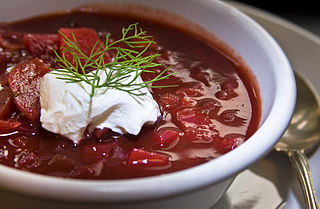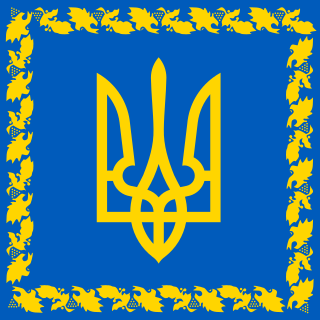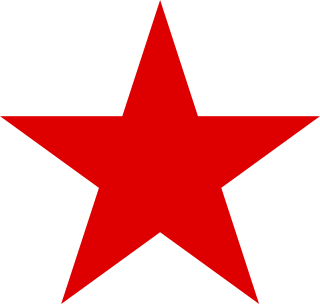 W
WA bandura is a Ukrainian, plucked string, folk instrument. It combines elements of the zither and lute and, up until the 1940s, was also often referred to by the term kobza. Early instruments had 5 to 12 strings and similar to the lute. In the 20th century, the number of strings increased initially to 31 strings (1926), then to 56 strings - 68 strings on modern 'concert' instruments (1954).
 W
WBorscht is a sour soup common in Eastern Europe and Northern Asia. In English, the word "borscht" is most often associated with the soup's variant of Ukrainian origin, made with beetroots as one of the main ingredients, which give the dish its distinctive red color. The same name, however, is also used for a wide selection of sour-tasting soups without beetroots, such as sorrel-based green borscht, rye-based white borscht and cabbage borscht.
 W
WBread and salt is a welcome greeting ceremony in some Slavic, Nordic, Baltic, Balkan and other European cultures as well as in Middle Eastern cultures. The tradition, known by local Slavic names, is also shared with some non-Slavic nations — Lithuanians, Latvians, Romanians (Romance) as well as some Finno-Ugric peoples like the Karelians — all of which are culturally and historically close to their Slavic neighbours. It is also common in Albania, Armenia, the Jewish diaspora, and the Middle East. This tradition has also been observed in spaceflight.
 W
WThe presidential bulava (mace) is one of the official symbols of the President of Ukraine. Made of gilded silver. The handle and top of the Mace of the President of Ukraine are decorated with decorative ornaments and decorated with precious stones.
 W
WThe coat of arms of the Ukrainian Soviet Socialist Republic was adopted on March 14, 1919 by the government of the Ukrainian Soviet Socialist Republic and subsequently modified on November 7, 1928, January 30, 1937 and November 21, 1949. The coat of arms from 1949 is based on the coat of arms of the Soviet Union and features the hammer and sickle, the red star, a sunrise and stalks of wheat on its outer rims. The rising sun stands for the future of the Soviet Ukrainian nation, the red star as well as the hammer and sickle for communism and the "world-wide socialist community of states".
 W
WThe coat of arms of Ukraine is a blue shield with a gold trident. Officially referred to as the Princely State Symbol of Volodymyr the Great, or, colloquially, the tryzub, the insignia derives from the seal-trident of Volodymyr, the Grand Prince of Kyiv.
 W
WThe sign (collar) of the President of Ukraine weighs about 400 grams. President’s collar is not obligatory, but most European heads of state have such a decoration: for instance, the President’s collar is one of the symbols of state power in Poland and Bulgaria. Some countries grant another collar to new head of the state, and the previous one passes to the national museums. An open-work chain with a historical relic – an amulet which, as the legend reads, belonged to Ukrainian Hetman Ivan Mazepa – was among the attributes of the President of Ukraine.
 W
WThe national colours of Ukraine are usually identified as the combination of blue and gold in that order. These colours are the same as in the flag of Ukraine. The roots of Ukrainian national colours come from before Christian times when yellow and blue prevailed in traditional ceremonies, reflecting fire and water. The most solid proof of yellow and blue colours could be traced as far as the Battle of Grunwald at which participating militia formations from various lands of the Polish-Lithuanian Union. In maps of the 19th and 20th centuries, the territories of Ukraine were usually coloured yellow. The "gold" (Or) is nearly always represented by a shade of yellow, as there is no distinct colour "yellow" in heraldry; they both count as "Gold". There is a theory that the colors have arrived in the area of present-day Ukraine, together with the governor Prinz Władysław II Opolczyk, who established them to the Principality of Ruthenia on model of his native Upper Silesia.
 W
WCossack Mamay is a Ukrainian folkloric hero, one of the standard characters in traditional Ukrainian itinerant puppet theater, the Vertep.
 W
WCossack with rifle, sometimes as Knight with rifle or Cossack with musket is a former national emblem of the Cossack Hetmanate. In 20th century it was the official national emblem of Ukrainian State.
 W
WThe Crown of Russia, also known as the Crown of Kingdom of Russia (Galicia–Volhynia), is the crown with which Daniel of Galicia was crowned in 1253 by a papal archbishop in Drohiczyn. The coronation of Daniel took place around the same time as Mindaugas.
 W
WThe Flag (Standard) of the President of Ukraine is the official flag of the President of Ukraine.
 W
WThe first flag of the Ukrainian Soviet Socialist Republic was adopted on 10 March 1919 to serve as the symbol of state of the Ukrainian SSR. Details of the official flag changed periodically before the break-up of the Soviet Union in 1991, but all had as their basis the red flag of the October Revolution. According to the decree of the Presidium of Supreme Soviet of Ukrainian SSR on 21 November 1949, the blue in the bottom symbolises the mightiness and beauty of the people, and the blue banner of Bohdan Khmelnytsky.
 W
WThe flag of Ukraine is a banner of two equally sized horizontal bands of blue and yellow. The combination of blue and yellow as a symbol of Ukrainian lands comes from the flag of the Kingdom of Galicia–Volhynia used in the 12th century. As a national flag, the blue and yellow bicolour has been officially used since the 1848 Spring of Nations, when it was hoisted over the Lviv Rathaus. It was officially adopted as a state flag for the first time in 1918 by the short-lived West Ukrainian People's Republic and subsequently used by the Ukrainian People's Republic. When Ukraine was part of the Soviet Union, the flag was outlawed and, before 1949, there was no official state flag until adoption of the red-azure flag of the Ukrainian SSR. The blue and yellow flag was provisionally adopted for official ceremonies in September 1991 following Ukrainian independence, before finally officially being restored on 28 January 1992 by the parliament of Ukraine.
 W
WThe flags of the subdivisions of Ukraine exhibit a wide variety of regional influences and local histories, as well as widely different styles and design principles. Most local flags were designed and adopted after 1991.
 W
W"Glory to Ukraine" is a Ukrainian national salute. It appeared at the beginning of the 20th century in different variations, when it became wildly popular among ethnic Ukrainians during the Ukrainian War of Independence of 1917–1921.
 W
WThe hammer and sickle is a symbol meant to represent proletarian solidarity – a union between the peasantry and the working class. It was first adopted during the Russian Revolution, the hammer representing workers and the sickle representing the farmers.
 W
WHelianthus annuus, the common sunflower, is a large annual forb of the genus Helianthus grown as a crop for its edible oil and edible fruits. This sunflower species is also used as wild bird food, as livestock forage, in some industrial applications, and as an ornamental in domestic gardens. The plant was first domesticated in the Americas. Wild Helianthus annuus is a widely branched annual plant with many flower heads. The domestic sunflower, however, often possesses only a single large inflorescence atop an unbranched stem. The name sunflower may derive from the flower's head's shape, which resembles the sun.
 W
WThe following is a list of flags of Ukraine:
 W
W"Shche ne Vmerla Ukrainy i slava, i volia", also known by its official title of "State Anthem of Ukraine" or by its shortened form "Shche ne vmerla Ukrainy", is the national anthem of Ukraine. Its music was officially adopted by Ukraine's Verkhovna Rada on 15 January 1992. The official lyrics were adopted on 6 March 2003 by the Law on the Anthem of Ukraine.
 W
WThe Peresopnytsia Gospels, dating from the 16th century, is one of the most intricate surviving East Slavic manuscripts. It was made between 15 August 1556 and 29 August 1561, at the Monastery of the Holy Trinity in Iziaslav, and the Monastery of the Mother of God in Peresopnytsia, Volyn'. The scribe was Mykhailo Vasyl’ovych, son of an archpriest from Sianik, who worked under the direction of Hryhorii, the archimandrite of the Peresopnytsia Monastery.
 W
WPierogi are filled dumplings made by wrapping unleavened dough around a savoury or sweet filling and cooking in boiling water. They are often pan-fried before serving.
 W
WUkraine's public diplomacy is an instrument of Ukraine's foreign policy aimed at promoting an attractive image of the state abroad through communication at the level of the public of other states. It includes the use of cultural diplomacy, social media, cooperation with non-governmental organizations and the Ukrainian diaspora, the creation and promotion of a state brand, and more. The impetus for the intensification of Ukrainian public diplomacy was the counteraction to Russia's armed aggression against Ukraine and the information war, Ukraine's search for foreign support, and the process of Ukraine's European and Euro-Atlantic integration.
 W
WA pysanka is a Ukrainian Easter egg, decorated with traditional Ukrainian folk designs using a wax-resist method. The word pysanka comes from the verb pysaty, "to write" or "to inscribe", as the designs are not painted on, but written (inscribed) with beeswax.
 W
WA red star, five-pointed and filled, is a symbol that has often historically been associated with communist ideology, particularly in combination with the hammer and sickle, but is also used as a purely socialist symbol in the 21st century. It has been widely used in flags, state emblems, monuments, ornaments, and logos.
 W
WThe Ruthenian lion, Ukrainian lion, or Halychian lion is a golden lion on an azure background. The coat of arms of the Kingdom of Rus, the Ruthenian Voivodeship and the Western Ukrainian People's Republic. Usually, he was depicted as stocky, less often — walking, crowned, with silver or red weapons; such that it rests on a gold or silver rock. The oldest images appear on the seals of n rulers from the XIV century — Yurii I of Galicia, Leo II of Galicia, Yurii II Boleslav, Vladislaus II of Opole. In the XV-XVI centuries the lion was present on the large seals of Kings Władysław II Jagiełło, Alexander Jagiellon, and Sigismund II Augustus as a symbol of Rus, along with the Polish eagle, the Lithuanian pahonia, and the Prussian eagle. As a voivodship emblem of Lwów Land in the form of a lion on a rock known since the XV century. Beginning with the Revolution in the Austrian Empire in 1848, he became one of the political symbols of the Ruthenians (Ukrainians) and the Ukrainian national liberation movement. In modern times it was perceived as the coat of arms of the western Ukrainian lands with the center in Lviv, mainly Halychyna. He was depicted with the emblems of Ukrainian military formations of the twentieth century — the Ukrainian Sich Riflemen (1914-1918) and the 14th SS-Volunteer Division "Galicia" (1943-1945). Since 2009 he has been one of the supporter of the project of the large coat of arms of Ukraine. It is used as a coat of arms in Ukrainian and Polish heraldry, in particular on the coats of arms of Lviv, Lviv Oblast, oblast raion, Częstochowa, Subcarpathian Voivodeship, etc. The colors of the coat of arms are the colors of the state flag of Ukraine — yellow (gold) and blue.
 W
WThe official seal of the President of Ukraine is ring-shaped. There is an image of the lesser Coat of Arms of Ukraine in the center of the stamp hemmed with “The President of Ukraine” inscription. Below the National Emblem is an image of the Order of Prince Yaroslav the Wise. The handle of the new seal is garnished with a lapis lazuli ball. The neck or central part of the seal is gilded; its colors are that of the national Flag of Ukraine – blue above and yellow below. The seal is made of silver and weighs next to half a kilogram. Kyiv jeweler Mykhailo Cheburakhin made it using sketches by Oleksiy Rudenko just for a week.
 W
WNational symbols are the sacred attributes for Ukrainian people. In Ukrainian graphics there exist a number of symbols and images from national songs, legends. Such symbols and imagery are used in national customs and rituals. They are reproduced in embroidery on national costumes, ritual cloth—rushnyks, painted on crockery, in forged products, in carving, in bas-relief house decoration, in hearth painting, pottery, engraving and also in Ukrainian traditional Easter eggs—pysankas.
 W
WViburnum opulus, the guelder-rose or guelder rose ) is a species of flowering plant in the family Adoxaceae native to Europe, northern Africa and central Asia.
 W
WVyshyvanka is a casual name for the embroidered shirt in Ukrainian and Belarusian national costumes. Ukrainian vyshyvanka is distinguished by local embroidery features specific to Ukrainian embroidery.